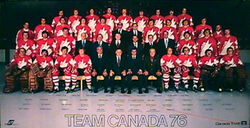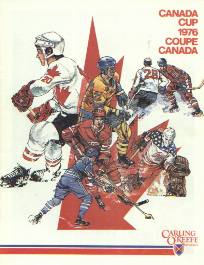
The 1976 Canada Cup was the first of 5 Canada Cup competitions. 6 teams were invited to participate, i.e. Canada, Czechoslovakia, Finland, the Soviet Union, Sweden and the United States. Each of the participating teams were asked to send the best team they could muster, meaning that World Hockey Association players, unlike during the 1972 and 1974 Summit Series, could participate. It took place on the first two weeks of September 1976.
Rosters[]
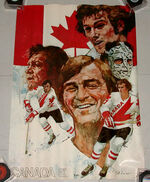
Canada  []
[]
Skaters: Bill Barber, Bobby Clarke, Marcel Dionne, Phil Esposito, Bob Gainey, Danny Gare, Bobby Hull, Guy Lafleur, Guy Lapointe, Reggie Leach, Peter Mahovlich, Richard Martin, Lanny McDonald, Bobby Orr, Gilbert Perreault, Denis Potvin, Larry Robinson, Serge Savard, Steve Shutt, Darryl Sittler, Carol Vadnais, Jimmy Watson
Goaltenders: Gerry Cheevers, Glenn Resch, Rogatien Vachon
Coaches: Scotty Bowman, Don Cherry, Bobby Kromm, Al MacNeil
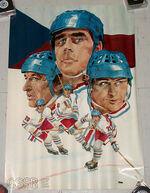
Czechoslovakia  []
[]
Skaters: Josef Augusta, Jiri Bubla, Frantisek Cernik, Milan Chalupa, Miroslav Dvorak, Bohuslav Ebermann, Ivan Hlinka, Jiri Holik, Karel Holy, Frantisek Kaberle, Milan Kajkl, Oldrich Machac, Vladimir Martinec, Jiří Novák, Milan Novy, Frantisek Pospisil, Jaroslav Pouzar, Pavel Richter, Vladimir Sandrik, Bohuslav Stastny, Marian Stastny, Peter Stastny Jiri Bubla
Goaltenders: Vladimir Dzurilla, Jiri Holecek
Coaches: Karel Gut, Jan Starsi
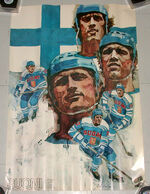
Finland  []
[]
Skaters: Tapio Flinck, Matti Hagman, Hannu Kapanen, Veli-Pekka Ketola, Pertti Koivulahti, Tapio Koskinen, Tapio Levo, Harri Linnonmaa, Lasse Litma, Kari Makkonen, Timo Nummelin, Lasse Oksanen, Esa Peltonen, Jouni Peltonen, Pekka Rautakallio, Matti Rautiainen, Seppo Repo, Heikki Riihiranta, Jouni Rinne, Timo Saari, Juhani Tamminen, Jorma Vehmanen
Goaltenders: Antti Leppänen, Markus Mattsson, Jorma Valtonen
Coaches: Lasse Heikkilä, Carl Brewer
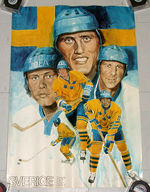
Sweden  []
[]
Skaters: Mats Ahlberg, Thommie Bergman, Per-Olov Brasar, Lars-Erik Eriksson, Roland Eriksson, Lars-Erik Esbjors, Inge Hammarström, Anders Hedberg, Björn Johansson, Dan Labraaten, Willy Lindström, Tord Lundström, Lars-Goran Nilsson, Ulf Nilsson, Stig Ostling, Börje Salming, Stig Salming, Lars-Erik Sjöberg, Jan-Olov Svensson, Mats Waltin, Juha Widing, Kjell-Arne Wikström
Goaltenders: Hardy Åström, Göran Högosta, William Löfqvist
Coaches: Tommy Sandlin, Bengt Ohlson
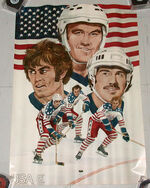
United States  []
[]
Skaters: Fred Ahern, Curt Bennett, Harvey Bennett, Jr., Dan Bolduc, Rick Chartraw, Mike Christie, Lee Fogolin, Robbie Ftorek, Alan Hangsleben, Steve Jensen, Mike Milbury, Lou Nanne, Joe Noris, Bill Nyrop, Gerry O'Flaherty, Doug Palazzari, Craig Patrick, Mike Polich, Gary Sargent, Dean Talafous, Warren Williams
Goaltenders: Mike Curran, Pete LoPresti, Cap Raeder
Coaches: Bob Pulford, Harry Neale
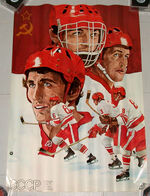
USSR  []
[]
Skaters: Boris Alexandrov, Sergei Babinov, Helmuts Balderis, Valeri Belousov, Zinetula Bilyaletdinov, Alexander Golikov, Alexander Gusev, Sergei Kapustin, Vladimir Kovin, Vladimir Krikunov, Alexander Kulikov, Viktor Kuznetsov, Yuri Lebedev, Vladimir Lutchenko, Alexander Maltsev, Vladimir Repnev, Viktor Shalimov, Alexander Skvortsov, Valeri Vasiliev, Vladimir Vikulov, Viktor Zhluktov
Goaltenders: Vladislav Tretiak, Mikhail Vasilenok, Viktor Zinger
Coaches: Viktor Tikhonov, Boris Mayorov, Robert Cherenkov
Background[]
The Canadian Amateur Hockey Association (CAHA) had complained for years that Team Canada faced a competitive disadvantage in international tournemnts as it was restricted from using its best players, who were professionals in the National Hockey League (NHL), while European teams masked the status of their best players.[1] The issue came to a head in 1970 when International Ice Hockey Federation (IIHF) president Bunny Ahearne reneaged on a promise to allow each team to use up to nine professional players at the 1970 World Championship.[2] In response, the CAHA withdrew Canada from all international competition until the IIHF gave it the right to use its best players as the European teams could.[3]
Around the same time, talks were begun to hold a friendly tournament between Canada's top players and the Soviet national team.[1] These talks culminated in the Summit Series in 1972 that was narrowly claimed by Canada's NHL all-stars.[4] A second Summit Series in 1974 saw the Soviets easily defeat the World Hockey Association's (WHA) top all-stars, but the two series created demand for a true best-on-best world championship.[5] It was during the 1974 Summit Series that National Hockey League Players Association (NHLPA) executive-director Alan Eagleson began negotiations with Soviet and European authorities to create such a tournament.[6] The negotiations, which grew to include the IIHF and Hockey Canada and lasted over two years, resulted in numerous agreements: Canada would return to international competition in 1977, the World Championships moved to an open format that allowed professionals to play and club teams of the Soviet League would tour North America and face NHL teams in what became the Super Series. The key agreement was the creation of the Canada Cup, to be held in 1976.[7]
Having gained international approval, Eagleson then convinced the NHLPA's players to support the tournament with promises of increased pension contributions as a result of the tournaments. The NHL's owners supported the concept after agreeing that half of the proceeds from the games would go to them. Some teams remained uneasy, however. The Philadelphia Flyers were afraid their players might suffer injuries in the tournament and vowed that no player from their roster would be permitted to play. They were convinced to back down on their threats after being promised that two games of the tournament would be played in Philadelphia, with the Flyers receiving their share of the revenue.[7] The tournament was also held in September so as not to interefere with the NHL season. League president Clarence Campbell remained skeptical of the tournament's viability, calling it "wasteful".[8]
Teams[]
Six teams competed in the 1976 Canada Cup. Canada was favoured to win as they had brought what was argued to be the strongest team in the nation's history to the tournament – 16 of the 21 players on the roster were elected into the Hockey Hall of Fame.[5] Seeking its best possible roster, the Canadian team put aside the bitter rivalry between the NHL and WHA, selecting players from both leagues, though overwhelmingly from the NHL.[9] Bobby Orr, plagued by growing knee problems nearly turned down the invitation to play before reconsidering, while goaltender Rogatien Vachon, who was not initially invited to join the team, wound up playing every minute in the Canadian goal.[10]
While the fans hoped for a Canada-Soviet Union final, analysts ranked the Soviets as only the fourth best team entering the tournament.[11] They chose to leave several top players home for reasons that remain unclear. Officially, Soviet officials said many of their players were suffering from fatigue, though goaltender Vladislav Tretiak later claimed the omissions were the result of a power struggle between Olympic coach Boris Kulagin and Canada Cup team coach Viktor Tikhonov and that the former sought to undermine the latter by forcing him to coach a weaker team.[11] The Soviets also sought to downplay the importance of the tournament, claiming their true focus was the World Championship and the Olympics.[12] As a result, they sent a much younger, "experimental" team to Canada.[5]
The Czechoslovakian team was predicted to face Canada in the final by most experts as they brought the same team that won the 1976 World Championhip a few months prior. Their goaltender, Jiří Holeček, was considered the best in the world outside the NHL.[13] Czech coach Karel Gut anticipated his team would emerge to show the world that there was "more to international hockey than Canada and the Soviet Union".[14] Sweden was ranked third entering the tournament and had a large mixture of amateurs and professionals who were playing in the NHL and WHA.[15] The United States and Finland rounded out the tournament and were not expected to be competitive.[16]
Round robin games[]
The tournament opened in Ottawa on September 2 as Finland faced a Canadian team focused on avoiding a sense of complacency following defeats against the Soviets in 1974 and 1975.[17] Rick Martin scored a hat trick to lead Canada in a rout of the Finns, 11–2.[18] Sweden then defeated the United States, 5–2, on the strength of four first period powerplay goals. Swedish star Börje Salming, who played in the NHL for the Toronto Maple Leafs, was greeted with a five-minute standing ovation by the Toronto crowd prior to the game.[19]
The third game featured the world champion Czechs against the Olympic champion Soviets. Czechoslovakia justified pre-tournament expectations by winning 5–3 while the Soviets complained about the scheduling, claiming organizers deliberately matched them up against the Czechs in their opening game to set them at an early disadvantage in the tournament.[20] The Soviet complaints grew louder following a 3–3 tie against Sweden. While the Swedish press was hailing Salming as the greatest player in their nation's history after his second consecutive dominant effort,[21] the Soviets threatened to quit the tournament as they were upset about the officiating of Canadian referee Andre Legace. Organizers did not take the Soviet threats to quit the tournament seriously.[22]
The Czechs remained dominant, defeating the Finns 8–0 in a game where they out-shot their opponent 49–15. Czech goaltender Holeček recorded the first shutout in the tournament's history.[23] The Finns were similarly decimated by the Soviets, who did not withdraw from the tournament, by an 11–3 score.[24] Meanwhile, the Americans, criticized in the media as being "team useless" over their perceived lack of talent, earned a measure of respect when they lost to Canada 4–2 in a game where the outcome was not certain until the final minute of play,[25] then earned a 4–4 tie against the Czechs, and the respect of their coach, in a game played at Philadelphia.[26]
A 4–0 loss to Canada followed by a shocking 8–6 defeat at the hands of their Scandinavian rival Finland eliminated Sweden from contention. The Finns, who overcame a 4–1 deficit, felt the result vindicated their placement in the tournament while the Swedes considered the result an embarrassment.[27] The Soviets remained alive by defeating the United States 5–0 in Philadelphia while Canada faced the Czechoslovaks at the same time in Montreal. The game featured a goaltender battle between Canada's Rogatien Vachon and the Czech's Vladimir Dzurilla and was immediately claimed to be one of the greatest games of all time.[28] Milan Nový scored with less than five minutes to play to lift the Czechs to a 1–0 victory and assured them a place in the final.[29] The result meant that the winner of the Canada–Soviet Union game would claim the second spot in the final.[30]
Three games marked the final day of the round robin on September 11. The United States overcame a 2–0 deficit to defeat Finland 6–3 to finish fifth in the tournament. American co-general manager Tommy Ivan expressed his pride in his team's tournament, and predicted that this tournament had set the stage for the United States to grow into a contender in hockey.[31] The Swedes, meanwhile, earned a 2–1 victory over Czechoslovakia in a game that had no impact on the standings.[32]
While fans expected Canada and the Soviet Union would meet in the final, ultimately, they squared off in an unofficial semi-final. The two teams played the game at a furious pace, trading goals in a first period from which Canada emerged with a 2–1 lead. Canada extended their lead in the second period then relied on defenceman Bobby Orr's stellar play to hold off the Soviets and advance to the final.[33] As they had earlier in the tournament, the Soviets complained of biased officiating playing a role in the outcome of the game.[34]
Final[]
The 1976 Canada Cup final was a best-of-three series. The first game was played September 13 at Maple Leaf Gardens in Toronto. The Czechs started Dzurilla in goal after his brilliant display against Canada in the round robin.[35] Dzurilla was unable to duplicate his success as Gilbert Perreault opened the scoring one minute into the game en route to a four goal onslaught by the Canadians in the first period.[35][36] The Czechs were stronger in the final 40 minutes, but were unable to beat Canada's Vachon, who recorded his second shutout of the tournament in a 6–0 victory for Canada.[35] During the game, the Czechs were angered when Canada's Steve Shutt crosschecked Jiri Novak from behind. Novak suffered a concussion and was unable to play the remainder of the series. Shutt was apologetic after the game, claiming he had not intended to hit his opponent in the fashion he did.[37]
Game two was played in the Montreal Forum on September 15. Jiri Holeček, who replaced Dzurilla in goal after the first period of the first game, started game two for Czechoslovakia, while Vachon remained in the Canadian net.[38] As they had in the first game, Canada jumped out to an early lead, scoring two goals in the first three minutes of play. Holeček was quickly pulled and replaced with Dzurilla, who completed the game.[38] The Czechs replied with a second period goal and another early in the third to tie the game. Bobby Clarke re-established the Canadian lead midway through the period before Josef Augusta and Marian Stastny scored goals one minute apart to give Czechoslovakia its first lead, 4–3, with four minutes remaining in the third period.[39] Dzurilla was strong in net as the Canadians put 39 shots on goal in regulation time, but made a critical mistake with less than three minutes remaining. His attempt to clear a puck from his zone went instead to Canada's Bill Barber, who scored into an open net to tie the game and send it to overtime.[40]
The teams played an intense overtime period filled with end-to-end rushes and brilliant saves by the goaltenders. At one point, Canada's Guy Lafleur put a shot on net that snuck through the Czech goaltender, but Ivan Hlinka deliberately shoved the net out of place before the puck crossed the line. He received a delay of game penalty, but prevented a Canadian win. A few moments later, Guy Lapointe rifled a low shot that again beat Dzurilla, however this goal was also disallowed as the buzzer had sounded to end the first ten-minutes of the overtime period one-tenth of a second before it crossed the line. International rules of the time dictated that play was to be stopped at the ten minute mark of each overtime period and the teams would switch the side of the ice they defended.[40] During the break, Canadian assistant coach Don Cherry noted to his team that Dzurilla often came far out of his net to defend and could be beaten on a shot from a sharp angle.[41]
Less than two minutes into the second half of the overtime period, Darryl Sittler received a pass from Marcel Dionne as he skated into the Czech zone close to the side boards. As Dzurilla came out to challenge, Sittler faked a shot that froze the goaltender, took two more strides then fired the puck into an open net.[36] The goal touched off a wild celebration amongst the Canadian players on the ice and the fans in the stands. Sittler's championship winning goal remains one of the most famous in hockey history.[40] During the celebrations, the players of both teams traded uniforms; Bobby Orr was presented with the Most Valuable Player award while wearing a Czech jersey.[42] Prime Minister Pierre Trudeau presented Canadian captain Bobby Clarke with the Canada Cup.[40]
Legacy[]
The tournament finale was the most watched television event in Canadian history at the time. 10,700,000 people were estimated to have watched the game, representing nearly half of all Canadians in 1976.[43] The team that represented Canada is still considered one of the greatest national teams to ever represent the nation in a hockey tournament.[44] For many players, winning the Canada Cup was the highlight of their careers. Bobby Orr and Lanny McDonald both rated winning this tournament ahead of winning the Stanley Cup.[44]
The Canada Cup established a new era in international hockey. It marked Canada's formal return to the international stage after a six year boycott,[36] and was the first true best-on-best world championship in the sport's history.[45] For North American audiences, the tournament established that Czechoslovakia and Sweden could compete with Canada and the Soviet Union, while the Finns and Americans proved they were capable of playing with the sport's elite teams.
Standings[]
| Team | GP | W | L | T | GF | GA | DIF | PTS |
|---|---|---|---|---|---|---|---|---|
| Canada |
5 | 4 | 1 | 0 | 22 | 6 | +16 | 8 |
| Czechoslovakia |
5 | 3 | 1 | 1 | 19 | 9 | +10 | 7 |
| Soviet Union |
5 | 2 | 2 | 1 | 23 | 14 | +9 | 5 |
| Sweden |
5 | 2 | 2 | 1 | 16 | 18 | –2 | 5 |
| United States |
5 | 1 | 3 | 1 | 14 | 21 | –7 | 3 |
| Finland |
5 | 1 | 4 | 0 | 16 | 42 | –26 | 2 |
Results[]
Round-robin[]
| September 2, 1976 | Canada |
11–2 ( 4–1, 2–0, 5–1 ) |
Ottawa Civic Centre Attendance: 9,500 |
| Game reference | ||||
|---|---|---|---|---|
| Rogatien Vachon | Goalies | Antti Leppanen (07:11) Markus Mattsson (52:49) |
||
| Martin, (Lafleur, Lapointe) – (PP) 03:54 Hull, (Orr, Potvin) – 06:38 Esposito (Hull, Orr) – 07:11 Hull – 12:20 Leach (Orr, Martin) – (PP) 23:13 Shutt (Savard, Mahovlich) – 26:06 Martin, (Potvin, Perreault) – 40:48 Esposito (Mahovlich, Savard) – 48:25 Martin, (Perreault, Lafleur) – 51:12 Perreault, Lafleur, Martin) – 51:38 Sittler – (SH) 55:52 |
1–0 2–0 3–0 4–0 4–1 5–1 6–1 7–1 7–2 8–2 9–2 10–2 11–2 |
17:09 – Oksanen (Peltonen) 41:42 – Makkonen (Levo, Koskinen) | ||
| 12 min | Penalties | 6 min | ||
| 42 | Shots | 24 | ||
| September 3, 1976 | United States of America |
2–5 ( 0–5, 0–0, 2–0 ) |
Maple Leaf Gardens Attendance: 12,211 |
| Game reference | ||||
|---|---|---|---|---|
| Mike Curran | Goalies | Hardy Åström | ||
Talafous, (Ftorek) – 44:21 Talafous, (Ftorek) – 58:24 |
0–1 0–2 0–3 0–4 0–5 1–5 2–5 |
06:56 (PP2) – B. Salming (Johansson, Hammarstrom) 07:39 (PP) – R. Eriksson (Hedberg, Waltin) 14:16 (PP) – Hedberg, (Bergman, R. Eriksson) 15:45 – Widing (Lundstrom, Hammarstrom) 19:27 (PP) – Lundstrom (Widing, B. Salming) | ||
| 34 min | Penalties | 12 min | ||
| 29 | Shots | 37 | ||
| September 3, 1976 | Soviet Union |
3–5 ( 0–2, 1–1, 2–2 ) |
Montreal Forum Attendance: 16,193 |
| Game reference | ||||
|---|---|---|---|---|
| Vladislav Tretiak | Goalies | Jiří Holeček | ||
Maltsev – (SH) 21:07 Balderis (Shalimov) – 44:00 Kovin, (Skvortsov, Gusev) – 53:59 |
0–1 0–2 1–2 1–3 2–3 2–4 2–5 3–5 |
12:09 – Nový (Pospíšil) 19:21 – Pospíšil (Augusta, Nový) 39:38 – Nový (P. Šťastný, Macháč) 44:33 – B. Šťastný (Martinec, Novák) 53:06 – Martinec (Bubla) | ||
| 12 min | Penalties | 12 min | ||
| 18 | Shots | 30 | ||
| September 5, 1976 | Sweden |
3–3 ( 2–0, 0–1, 1–2 ) |
Montreal Forum Attendance: 14,215 |
| Game reference | ||||
|---|---|---|---|---|
| Hardy Åström | Goalies | Vladislav Tretiak | ||
| U. Nilsson (Hedberg, Bergman) – 07:48 B. Salming (Sjoberg, U. Nilsson) – (PP2) 13:12 Hedberg (B. Salming) – 57:28 |
1–0 2–0 2–1 2–2 2–3 3–3 |
29:42 – Kapustin (Maltsev, Vasiliev) 49:46 – Balderis (Zhluktov, Babinov) 51:24 – Kapustin (Maltsev, Repnev) | ||
| 12 min | Penalties | 12 min | ||
| 33 | Shots | 20 | ||
| September 5, 1976 | Finland |
0–8 ( 0–1, 0–3, 0–4 ) |
Maple Leaf Gardens Attendance: 16,309 |
| Game reference | ||||
|---|---|---|---|---|
| Antti Leppanen | Goalies | Jiří Holeček | ||
| 0–1 0–2 0–3 0–4 0–5 0–6 0–7 0–8 |
10:34 – Martinec (E. Novák, B. Šťastný) 24:11 – Augusta (Nový, P. Šťastný) 31:22 – Ebermann (Kajkl, Hlinka) 39:21 – Bubla (Holík) 40:24 – Nový (Černík) 50:24 – Bubla (M. Šťastný) 55:26 (PP) – Chalupa (Dvořák) 59:00 – Pouzar (M. Šťastný, P. Šťastný) | |||
| 14 min | Penalties | 12 min | ||
| 15 | Shots | 49 | ||
| September 5, 1976 | United States of America |
2–4 ( 0–3, 2–0, 0–1 ) |
Montreal Forum Attendance: 16,339 |
| Game reference | ||||
|---|---|---|---|---|
| Pete LoPresti | Goalies | Rogatien Vachon | ||
Ahern (C. Bennett, Nyrop) – 30:33 Jensen – 36:39 |
0–1 0–2 0–3 1–3 2–3 2–4 |
4:47 (PP) – Esposito (Dionne, Orr) 12:51 (PP) – Mahovlich (Orr, Shutt) 18:15 – Hull (Dionne, Potvin) 59:47 (EN) – Sittler (Mahovlich) | ||
| 12 min | Penalties | 8 min | ||
| 16 | Shots | 35 | ||
| September 7, 1976 | Soviet Union |
11–3 ( 4–2, 4–1, 3–0 ) |
Montreal Forum Attendance: 16,500 |
| Game reference | ||||
|---|---|---|---|---|
| Vladislav Tretiak | Goalies | Markus Mattsson (26:42) Antti Leppanen (33:18) |
||
| Maltsev (Vasiliev, Kapustin) – (PP) 3:27 Zhluktov (Balderis, Alexandrov) – (PP) 7:19 Zhluktov (Vasiliev, Kapustin) – PP 9:14 Repnev (Guzev, Maltsev) – (PP) 13:49 Zhluktov (Guzev, Balderis) – 25:11 Maltsev (Kapustin) – 26:42 Kapustin (Repnev, Maltsev) – 28:55 Zhluktov (Balderis, Bilyaletdinov) – 30:12 Vikulov (Alexandrov, Zhluktov) – 49:09 Vikulov (Zhluktov, Guzev) – 56:25 Kovin (Skvortsov, Belousov) – 57:12 |
1–0 1–1 2–1 3–1 4–1 4–2 4–3 5–3 6–3 7–3 8–3 9–3 10–3 11–3 |
3:57 – Rautakallio (Hagman, Kapanen) 18:23 – Makkonen (Koskinen, Rautiainen) 23:09 (PP) – Hagman (Nummelin) | ||
| 8 min | Penalties | 8 min | ||
| 41 | Shots | 31 | ||
| September 7, 1976 | Czechoslovakia |
4–4 ( 0–0, 2–4, 2–0 ) |
Philadelphia Spectrum Attendance: 17,077 |
| Game reference | ||||
|---|---|---|---|---|
| Jiří Holeček (31:02) Vladimír Dzurilla (28:58) |
Goalies | Mike Curran | ||
| Hlinka (Holík, P. Šťastný) – (PP) 21:06 Bubla (Hlinka) – 30:13 Hlinka (M. Šťastný) – 45:30 Augusta (Nový) – 54:06 |
1–0 1–1 1–2 1–3 2–3 2–4 3–4 4–4 |
25:21 – Hangsleben (Noris, O'Flaherty) 28:35 – Patrick (Bennett, Williams) 29:26 – Patrick (Williams, Bennett) 31:02 – Ftorek (Milbury, Talafous) | ||
| 2 min | Penalties | 10 min | ||
| 35 | Shots | 25 | ||
| September 7, 1976 | Sweden |
0–4 ( 0–1, 0–2, 0–1 ) |
Maple Leaf Gardens Attendance: 16,485 |
| Game reference | ||||
|---|---|---|---|---|
| Hardy Åström | Goalies | Rogatien Vachon | ||
| 0–1 0–2 0–3 0–4 |
4:12 – Hull (Esposito, Dionne) 31:11 – Gainey (McDonald, Savard) 39:40 – Dionne (Mahovlich) 50:26 – Gainey (Sittler, Orr) | |||
| 8 min | Penalties | 18 min | ||
| 28 | Shots | 33 | ||
| September 9, 1976 | Sweden |
6–8 ( 3–1, 2–4, 1–3 ) |
Winnipeg Arena Attendance: 8,037 |
| Game reference | ||||
|---|---|---|---|---|
| Hardy Åström | Goalies | Antti Leppanen | ||
| Johansson (B. Salming, Lundström) – 10:15 Hedberg (Labraaten) – 16:55 Hammarström (Johansson) – 17:16 Åhlberg (S. Salming, L. Eriksson) – (PP) 22:04 L. Eriksson (Åhlberg, Brasar) – 30:56 R. Eriksson (Lundström, Vikström) – (PP) 57:14 |
1–0 1–1 2–1 3–1 4–1 4–2 4–3 4–4 4–5 5–5 5–6 5–7 5–8 6–8 |
14:51 – Rautiainen (Repo, Koskinen) 22:21 – Hagman (Tamminen) 24:12 (PP) – Makkonen (Rautakallio, Riihiranta) 28:02 – Levo (Makkonen, Koivulahti) 34:35 – Tamminen (Hagman, Levo) 42:55 – Oksanen (Koivulahti, Riihiranta) 52:55 – Oksanen (Koivulahti) 54:24 (PP) – Tamminen (Repo, Hagman) | ||
| 8 min | Penalties | 8 min | ||
| 36 | Shots | 31 | ||
| September 9, 1976 | Soviet Union |
5–0 ( 3–0, 1–0, 1–0 ) |
Philadelphia Spectrum Attendance: 13,776 |
| Game reference | ||||
|---|---|---|---|---|
| Vladislav Tretiak | Goalies | Mike Curran | ||
| Alexandrov (Gusev, Vikulov) – 4:39 Alexandrov (Zhluktov, Vikulov) – 10:39 Zhluktov (Alexandrov, Vikulov) – 13:54 Vikulov (Kulikov) – 22:41 Repnev (Golikov) – 57:46 |
1–0 2–0 3–0 4–0 5–0 |
|||
| 18 min | Penalties | 32 min | ||
| 30 | Shots | 22 | ||
| September 9, 1976 | Czechoslovakia |
1–0 ( 0–0, 0–0, 1–0 ) |
Montreal Forum Attendance: 17,346 |
| Game reference | ||||
|---|---|---|---|---|
| Vladimír Dzurilla | Goalies | Rogatien Vachon | ||
| M. Nový (J. Augusta, V. Martinec) – 55:41 | 1–0 | |||
| 4 min | Penalties | 4 min | ||
| 23 | Shots | 29 | ||
| September 11, 1976 | Finland |
3–6 ( 2–0, 0–4, 1–2 ) |
Montreal Forum Attendance: 12,427 |
| Game reference | ||||
|---|---|---|---|---|
| Antti Leppanen | Goalies | Pete LoPresti | ||
| Repo (Rautakallio, Hagman) – 17:12 Linnonmaa (Koivulahti) – 19:45 Rautakallio (Linnonmaa, Riihiranta – (PP) 55:55 |
1–0 2–0 2–1 2–2 2–3 2–4 2–5 2–6 3–6 |
27:20 – Ahern (Polich, Bennett) 32:29 – Ftorek (Hangsleben, Milbury) 36:03 – Milbury (Patrick, Williams) 39:48 – Ftorek (Talafous, Milbury) 48:03 – Nyrop (Patrick, Nanne) 50:04 – Polich (Nanne, Bennett) | ||
| 8 min | Penalties | 18 min | ||
| 23 | Shots | 24 | ||
| September 11, 1976 | Sweden |
2–1 ( 0–0, 0–1, 2–0 ) |
Colisée de Quebec Attendance: 7,500 |
| Game reference | ||||
|---|---|---|---|---|
| Goran Hogosta | Goalies | Vladimír Dzurilla | ||
B. Salming (Sjöberg, L. Eriksson) – (PP) 40:31 B. Salming (Sjöberg, R. Eriksson) – (PP) 47:41 |
0–1 1–1 2–1 |
11:03 (PP) – Martinec (Macháč) | ||
| 6 min | Penalties | 20 min | ||
| 25 | Shots | 28 | ||
| September 11, 1976 | Canada |
3–1 ( 2–1, 1–0, 0–0 ) |
Maple Leaf Gardens Attendance: 16,485 |
| Game reference | ||||
|---|---|---|---|---|
| Rogatien Vachon | Goalies | Vladislav Tretiak | ||
| Perreault (Potvin, Lafleur) – (PP) 7:08 Hull (Perreault, Potvin – 17:02 Barber (Clarke, Lapointe) – 37:33 |
1–0 1–1 2–1 3–1 |
10:22 – Vikulov Alexanrov, Lutchenko) | ||
| 6 min | Penalties | 6 min | ||
| 43 | Shots | 28 | ||
Final (best of three)[]
| September 13, 1976 | Canada |
6–0 ( 4–0, 0–0, 2–0 ) |
Maple Leaf Gardens Attendance: 16,485 |
| Game reference | ||||
|---|---|---|---|---|
| Rogatien Vachon | Goalies | Vladimír Dzurilla (20:00) Jiří Holeček (40:00) |
||
| Perreault (Dionne, Hull) – 01:05 Potvin (Sittler, Lapointe) – 07:56 Orr (Esposito) – (PP) 13:34 Lafleur (Shutt, Orr) – 17:01 Orr (Esposito, Lapointe) – 51:35 D. Sittler (D. Potvin) – 59:59 |
1–0 2–0 3–0 4–0 5–0 6–0 |
|||
| 10 min | Penalties | 10 min | ||
| 34 | Shots | 24 | ||
| September, 15 1976 | Czechoslovakia |
4–5 ( 0–2, 1–0, 3–2, 0–1 ) |
Montreal Forum Attendance: 18,040 |
| Game reference | ||||
|---|---|---|---|---|
| Jiří Holeček (03:09) Vladimír Dzurilla (68:24) |
Goalies | Rogatien Vachon | ||
Nový (Martinec, Macháč) – (PP) 29:44 Pouzar (M. Šťastný, Chalupa) – 42:14 Augusta (Macháč, Martinec) – (PP) 55:01 M. Šťastný (Holík, Bubla) – 56:00 |
0–1 0–2 1–2 2–2 2–3 3–3 4–3 4–4 4–5 |
01:25 – Perreault (Lafleur, Potvin) 03:09 – Esposito (Potvin) 47:48 (PP) – Clarke (Hull, Perreault) PP 57:48 – Barber (Leach, Clarke) 71:33 – Sittler (Dionne, McDonald) | ||
| 14 min | Penalties | 10 min | ||
| 25 | Shots | 39 | ||
Statistical leaders[]
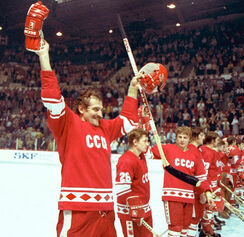
Viktor Zhluktov tied for the scoring lead.
Scoring[]
| Player | Team | GP | G | A | Pts | PIM |
|---|---|---|---|---|---|---|
| Viktor Zhluktov | Soviet Union | 5 | 5 | 4 | 9 | 0 |
| Bobby Orr | Canada | 7 | 2 | 7 | 9 | 8 |
| Denis Potvin | Canada | 7 | 1 | 8 | 9 | 16 |
| Bobby Hull | Canada | 7 | 5 | 3 | 8 | 2 |
| Milan Nový | Czechoslovakia | 7 | 5 | 3 | 8 | 2 |
| Gilbert Perreault | Canada | 7 | 4 | 4 | 8 | 2 |
| Vladimir Vikulov | Soviet Union | 4 | 4 | 3 | 7 | 0 |
| Börje Salming | Sweden | 5 | 4 | 3 | 7 | 2 |
| Phil Esposito | Canada | 7 | 4 | 3 | 7 | 0 |
| Alexander Maltsev | Soviet Union | 7 | 3 | 4 | 7 | 2 |
| Vladimír Martinec | Czechoslovakia | 7 | 3 | 4 | 7 | 2 |
Goaltending[]
| Player | Team | GP | Min | W | L | T | SO | SV% | GAA |
|---|---|---|---|---|---|---|---|---|---|
| Rogatien Vachon | Canada | 7 | 432 | 6 | 1 | 0 | 2 | .940 | 1.39 |
| Vladimír Dzurilla | Czechoslovakia | 5 | 228 | 1 | 2 | 1 | 1 | .920 | 2.36 |
| Vladislav Tretiak | Soviet Union | 5 | 300 | 2 | 1 | 2 | 1 | .912 | 2.80 |
| Pete LoPresti | United States | 2 | 120 | 1 | 1 | 0 | 0 | .895 | 3.00 |
| Jiří Holeček | Czechoslovakia | 5 | 203 | 2 | 1 | 0 | 1 | .861 | 3.25 |
- Minimum 120 minutes played[47]
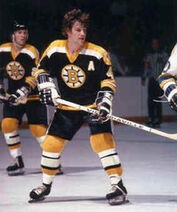
Bobby Orr tournament MVP
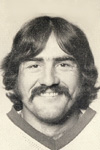
Rogatien Vachon All-Star Goaltender and Canada's MVP
Awards[]
| Recipient | Team |
|---|---|
| Most Valuable Player | |
| Bobby Orr | Canada |
| All-Star team | |
| G – Rogatien Vachon | Canada |
| D – Bobby Orr | Canada |
| D – Börje Salming | Sweden |
| F – Aleksandr Maltsev | Soviet Union |
| F – Milan Nový | Czechoslovakia |
| F – Darryl Sittler | Canada |
| Team MVPs | |
| Rogatien Vachon | Canada |
| Milan Nový | Czechoslovakia |
| Matti Hagman | Finland |
| Aleksandr Maltsev | Soviet Union |
| Börje Salming | Sweden |
| Robbie Ftorek | United States |

